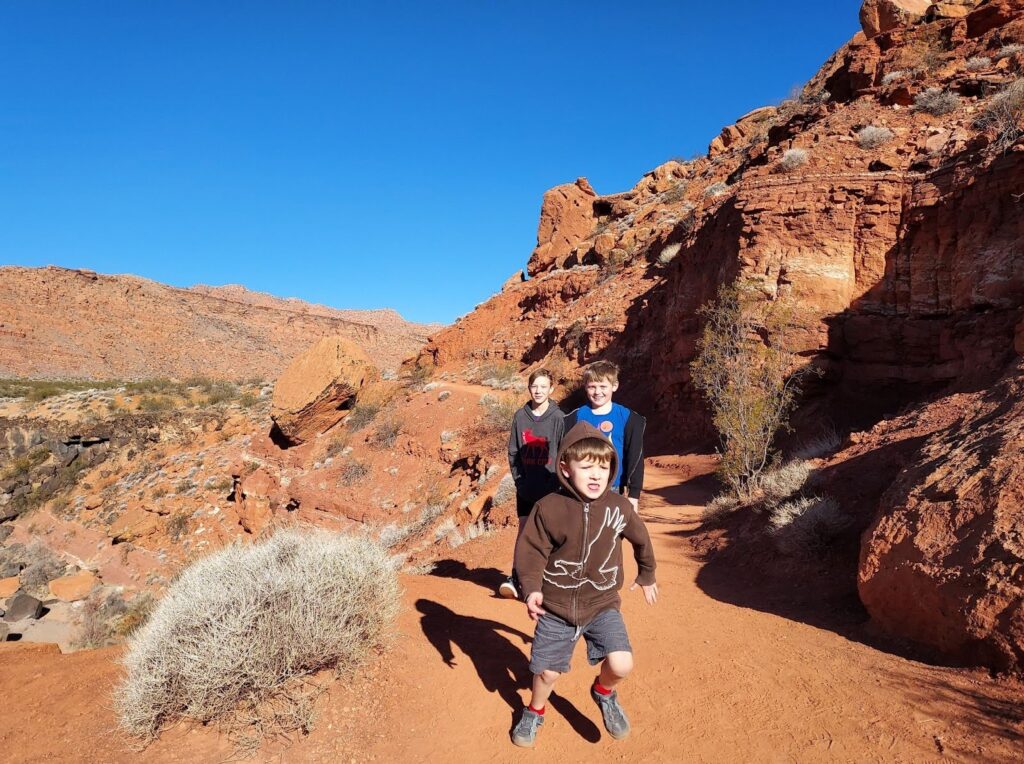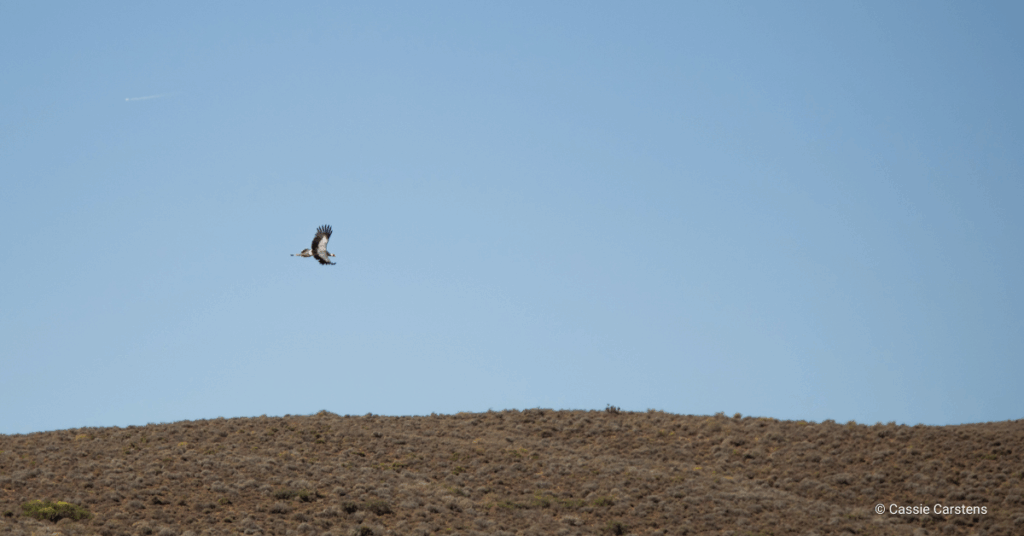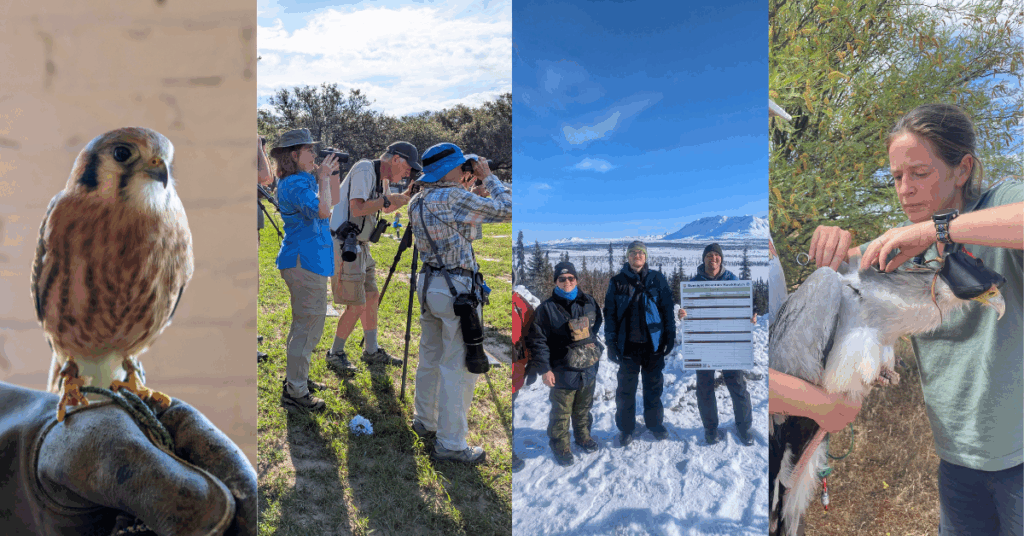Most of us at HawkWatch International not only love raptors; we also love everything to do with the great outdoors and spending as much time outside as possible. Recreating in spaces that our raptor friends and other wildlife call home, however, comes with a responsibility. In this blog, I’ll talk about the recent growth in outdoor recreation, some of the common ways we come into conflict with raptors while recreating, and how best to avoid or minimize those conflicts. With a little awareness, we can share the land, have meaningful outdoor experiences, and even contribute to raptor science!

Growing Recreation and Increasing Conflict
In recent years, the scale and diversity of recreation activities taking place in outdoor spaces has increased dramatically. From hiking to mountain biking (and e-biking), from horseback to OHV riding, from tent camping to van life, more and more people are taking up outdoor activities like birding, photography, climbing, canyoneering, backcountry skiing, geocaching, target shooting, rock hounding, and drone flying. Then there are activities that you may have never even considered, like jumping off a cliff in a wingsuit, setting up a cross-canyon highline, or swinging from an arch! As someone who has spent nearly two decades revisiting some of the same remote western landscapes to study raptors or take part in my own recreation activities, it is clear that the growth and diversification of recreation in the past five years has been nothing short of breathtaking. Growing the public’s interest in the outdoors should be a good thing. We protect what we love, right? But how do we avoid loving these places to death, as the saying goes?
For raptors, much of the conflict related to recreation comes from disturbance.
We often don’t notice their nests or roost sites on the cliffs, canyon walls, or in the forest while we pass through. If it is a quick pass, this isn’t usually a problem. It is when we linger in their space that we’re likely to cause harm. And some raptors will aggressively let us know when we’ve ventured too close, with the real possibility of injury to us! When a raptor leaves its nest, it can lead to exposure of the eggs or young—or even predation by ravens. Obviously, some activities, such as climbing, have a greater likelihood of conflict, but raptors can and do nest in a diversity of habitats and on nearly every type of surface you can imagine.

Learning to Share
So, what can we do to protect raptors from our recreational habits? Of course, we need laws and regulations to protect wild places and limits on what types of recreation can occur, when and where. We fully accept that a public pool or restaurant has to place capacity limits, even if it means sometimes we can’t get in. Keep this in mind the next time you participate in a lottery for the chance to enjoy a remote and special place or wait in line for a park shuttle! Please respect seasonal closures that exist in some areas to protect raptor nests, too. But a huge amount of outdoor recreation takes place off the beaten path where there are few (known) rules, even fewer rule enforcers, and no safety nets. It then falls on us to manage our own behavior, as well as the safety and well-being of those we share space with. It’s important to be alert for signs of disturbance and to be willing to adjust your plans to accommodate raptors. The following tips can help you make the most of your time outside without causing undue harm to raptors or the landscapes they depend upon:
- Be prepared. Know where you are going and what to expect in terms of terrain, wildlife, and possible sensitive areas (e.g., cliffs, canyons, etc.). Knowing what to expect in an area can prepare you for potential conflicts, and the right camera or optic equipment can allow you to view raptors and other wildlife from safe distances.
- Respect their space. Most raptors will let you know when you’ve made them uncomfortable by alarm calls, body posture, flushing, or dive bombing. Disturbing raptors can cause stress, nest failure, abandonment of young, or predation. Don’t compromise wildlife’s well-being (and your possible safety!) for a photograph or experience.
- Protect their habitat. Human-caused fire and the spread of invasive vegetation are huge threats to raptors and other wildlife habitat. Stay on existing roads and trails, don’t park on tall, dry vegetation, be aware of fire and shooting restrictions, and douse your fire when camping.
- Slow down. Wildlife, including raptors, regularly cross and are attracted to dirt and paved roadways for a variety of reasons. Slow down to avoid collisions. If you do strike an animal, move it at least 40 feet from the road to avoid secondary impacts to scavengers like eagles, assuming you can do so safely.
- Be an influencer. Help others play by the rules. If you see irresponsible behavior in the field or in photographs, help educate your friends. On the flip side, your community science data (e.g., eBird) can help advance our understanding of raptor distributions. Just don’t share the locations of sensitive features like raptor nests with anyone except the professionals!
This blog was written by Dr. Steve Slater, HWI’s Conservation Science Director. You can learn more about Steve here.



